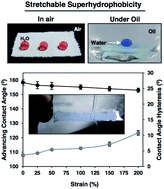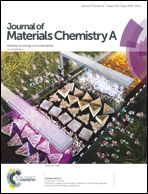Stretchable and durable superhydrophobicity that acts both in air and under oil†
Abstract
Stretchable and durable superhydrophobic materials are of potential interest for developing ultra-flexible electronics, flexible microfluidics, gas sensors, functional textiles, wearable devices etc. In general, the physical deformation of a material compromises the embedded antifouling property through perturbation of appropriate surface topography, and appears as a potential ‘Achilles' heel’ of the application of this prospective antifouling property in practical settings. Here we report a highly stretchable and durable superhydrophobic membrane that strongly repels aqueous phase both in air and under oil, by strategically exploiting a facile and robust 1,4-conjugated addition reaction between amine and acrylate groups from branched poly(ethyleneimine) (BPEI) and dipentaerythritol pentaacrylate (5Acl), respectively, where amine ‘reactive’ (due to the presence of residual acrylate groups) nanocomplexes—which were formed on just mixing of BPEI and 5Acl in ethanol—were directly immobilized on a modified polyurethane fibrous substrate to adopt appropriate topography, and further covalent modification of these immobilized ‘reactive’ nanocomplexes with strategically selected small molecules (i.e. octadecylamine) ensured the essential surface chemistry in the synthesized material. In the current design, scalable and facile dip coating (through covalent chemistry) followed by appropriate post-chemical modifications of the material yielded a highly durable superhydrophobicity—which is capable of being sustained, even at 150% physical deformation of the material for 1000 times without compromising the embedded antifouling property. Moreover, the synthesized material can survive exposure to various other physical and chemical insults—which are common in practical settings. The synthesized material is further exploited in energy efficient and rapid separation of both heavy and light oils from complex (sea, river, extremes of pH etc.) aqueous phases, where oil can be separated with a rate of 115 mL min−1 and with efficiency above 99% for multiple times.



 Please wait while we load your content...
Please wait while we load your content...